Technologies
iOS 17 Beta 3 for Developers Is Out Right Now for the iPhone
The third developer beta for iOS 17 is available for download.
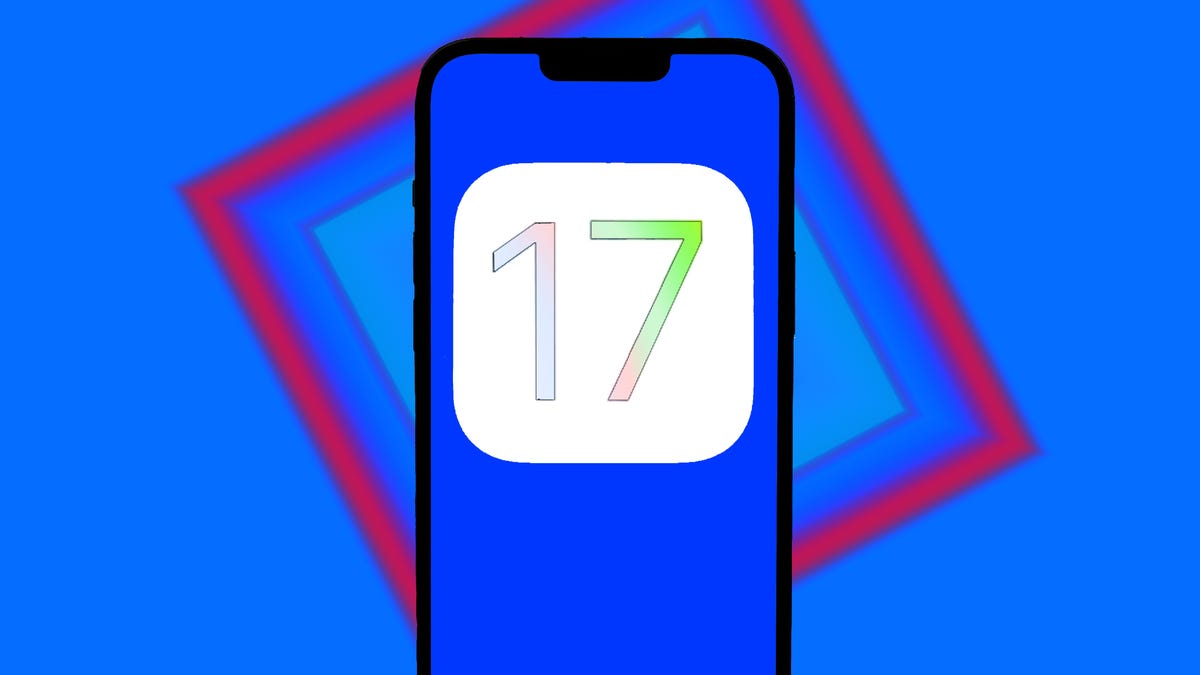
iOS 17 beta 3 is now available for developers. Apple is letting anyone with a compatible phone install the iOS 17 developer beta for free.
The company first announced iOS 17 at WWDC in June. Shortly after the keynote event, Apple released the first developer beta version of iOS 17. Typically, you have to pay $99 to officially download and install any Apple developer beta software, but this year the company is letting anyone get a crack at iOS 17 — as long as they join the Apple Developer Program.
Read more: Apple Unveils iOS 17 for the iPhone at WWDC 2023
iOS 17 emphasizes communication, with several new features for the Phone, FaceTime and Messages applications, including personalized contact posters, video messages, a more intelligent autocorrect, improved AirDrop options and the Journal app.

Before you go on and install iOS 17, you should know that developer beta versions like this aren’t intended for general use, especially because they may have unfinished features and issues that can make the iPhone difficult to use. These early beta releases are, instead, for developers, to help them keep their apps up to date and get early access to the upcoming features.
In short, you probably shouldn’t install the developer beta on your primary iPhone. If you really want to get iOS 17 right now, try to find a spare iPhone that is new enough (iPhone XS or later) to work with the latest software.
Read more: iOS 17 Is Coming This Year. Will It Work on Your iPhone?
For folks who still want to dive in, we’ll show you how to install the iOS 17 developer version on your iPhone, as well as what to do in case you want to revert to iOS 16.
Want to learn more about the stuff unveiled at WWDC? Here’s what you need to know about Vision Pro, Apple’s new augmented reality headset. And here’s all the dope on the new 15-inch MacBook Air and MacOS Sonoma.
What to know before you download the iOS 17 developer beta
Because the iOS 17 developer beta is an early prerelease version, the software could have bugs and other issues.
Again, if you’re thinking about downloading iOS 17, do it on a backup or secondary phone, if available. The iOS 17 developer beta’s issues could cripple your iPhone and make it difficult to use, disabling phone calls or text messages or making it extremely laggy. However, if you only have your main phone or tablet available, make sure to back up your iPhone on iOS 16.5 (the latest version of iOS 16) before updating to iOS 17. That way you have the option to return to iOS 16 if there are too many issues on the new OS.
Also, you must have an iPhone XS or later to run iOS 17. iOS 17 is not supported on the iPhone 8, iPhone 8 Plus and the iPhone X, all of which supported the iOS 16 developer beta last year.
And most importantly, to download the iOS 17 developer beta, you must be enrolled in the Apple Developer Program. The full membership is $99 a year, but as mentioned above, Apple is now offering a free membership option, with limited tools and resources, that allows pretty much anyone to download and install the iOS 17 developer beta for free.
You can also wait to join the Apple Beta Software program next month, which will provide a more stable iOS 17 upgrade than the developer version.
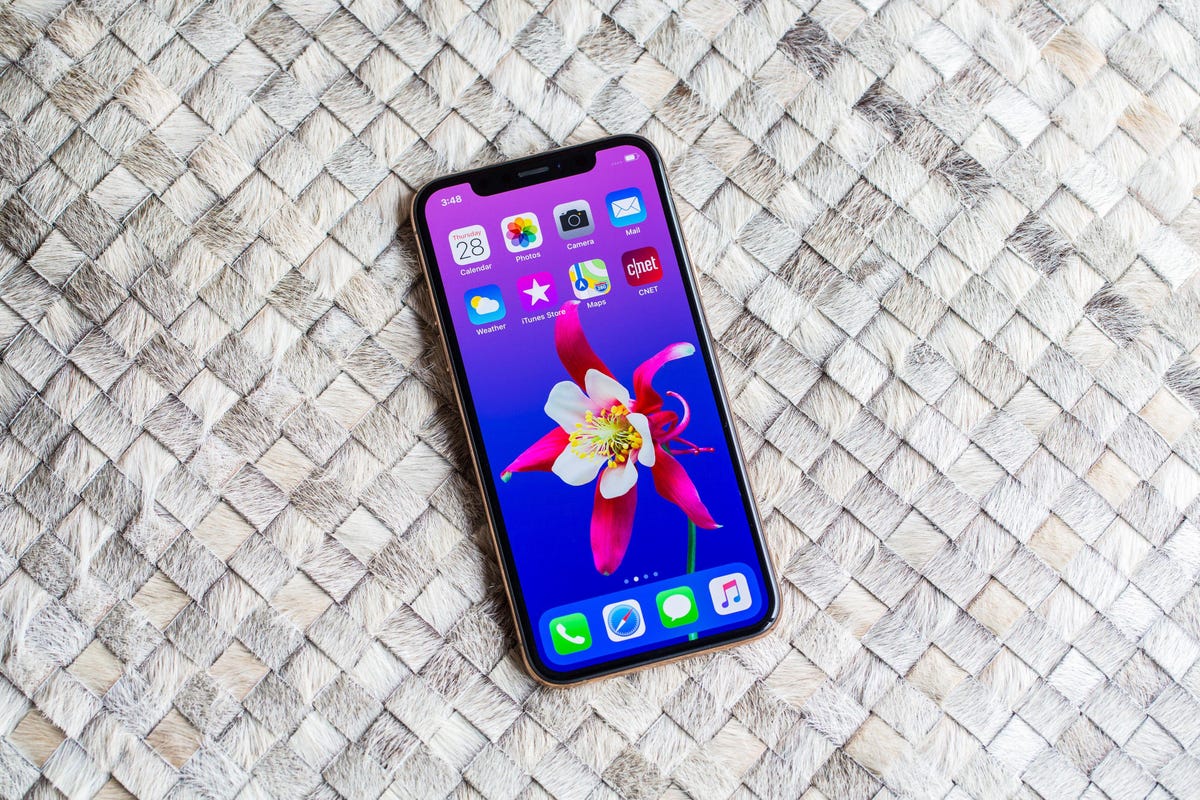
How to enroll in the Apple Developer Program, for free
If you’re only interested in testing out the iOS 17 developer beta for fun, you don’t need to pay for an Apple Developer Program membership. You can easily use your existing Apple ID to sign up for the developer program and download developer software onto your iPhone.
1. Go to Apple’s Developer website, tap the three-dash menu in the top-right and hit Account.
2. Sign in with your existing Apple ID.
3. Read through the Apple Developer Agreement, check the boxes at the bottom and then hit Submit.
You now have a free Apple Developer Program account. You can skip the next step to download and install the iOS 17 developer beta on your iPhone.
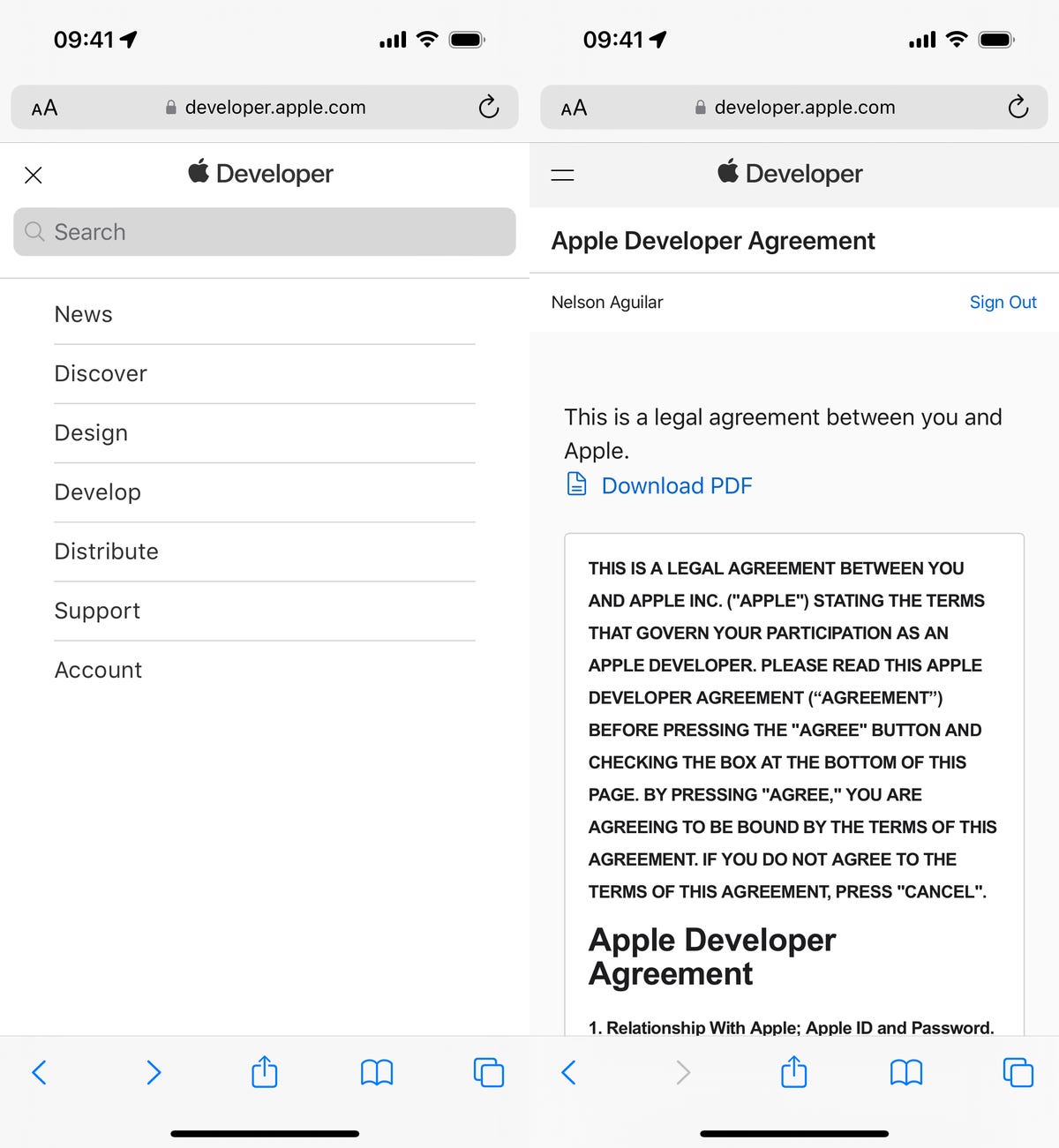
How to enroll in the paid Apple Developer Program
If you’re a developer, and want full access to development tools and the ability to distribute apps on the App Store, then you’ll want to pay for the Apple Developer Program. On your iPhone, here’s how you can enroll:
1. Download the Apple Developer app from the App Store, launch the app, go to Account and tap Enroll Now.
2. Sign in with your Apple ID credentials, read through the various benefits and instructions, enter your personal information and scan your ID to verify your identity.
3. Once this information is submitted, you must choose your entity (individual for most people) and agree to the program license agreement.
4. Finally, pay the Apple Developer membership fee (with Apple Pay), which is $99 (about £80 or AU$140) a year.
After you successfully make the payment, you’ll be redirected to your Account page in the Apple Developer app. Here you can verify that you’re now enrolled, and you can also check out the date of your membership’s expiration next year.
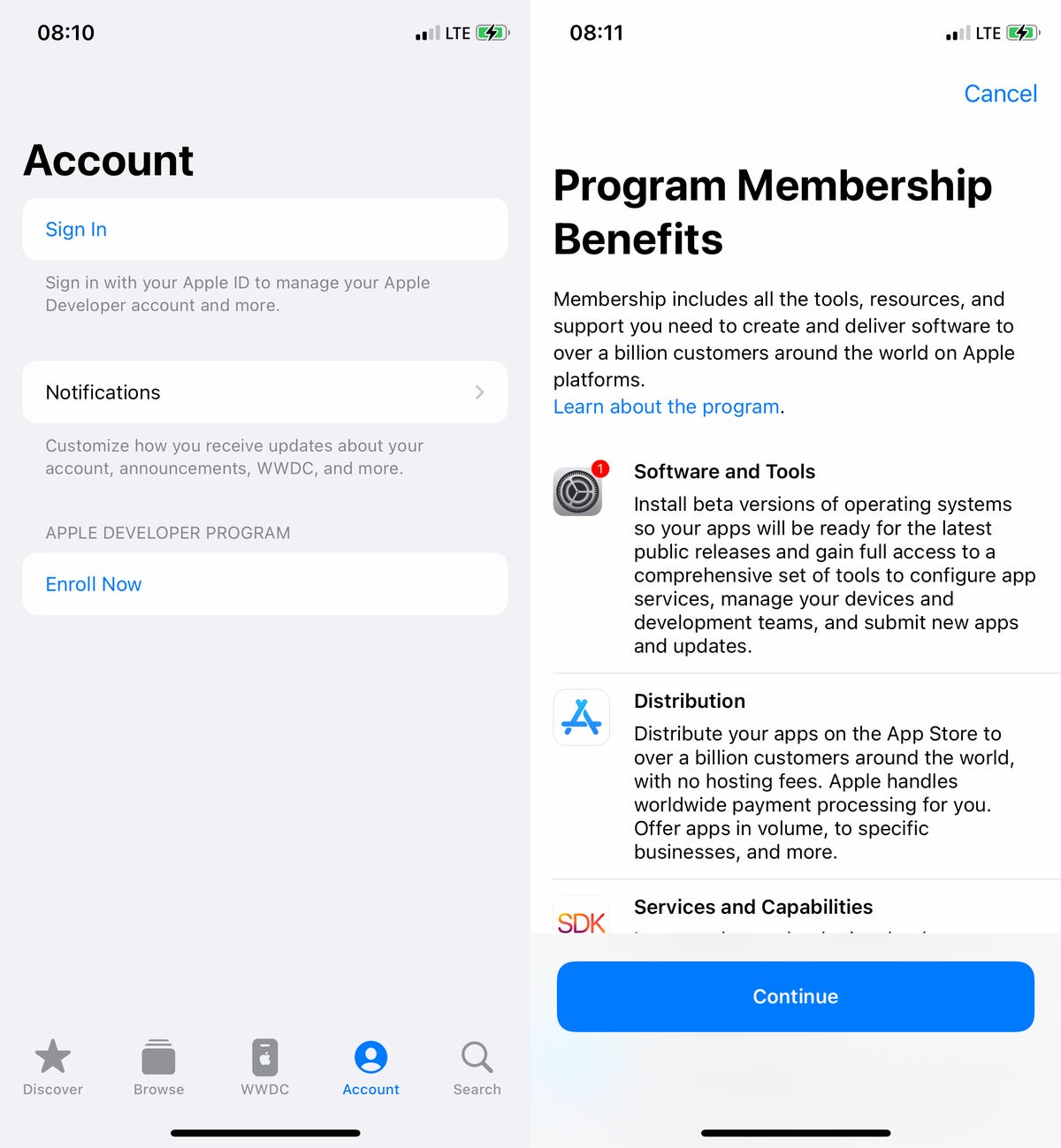
You can install iOS 17 with an over-the-air update on your iPhone
The easiest way to download the iOS 17 developer beta is with an over-the-air update — the way you would update to any other new software release on your device. Once you’re a member of the Apple Developer Program, free or paid, you’ll automatically have the option to install iOS 17 from your settings. Here’s how:
1. On your iPhone or iPad, go to the Settings > General > Software Update.
2. Next, go into Beta Updates and tap iOS 17 Developer Beta.
3. Go back and tap Download and Install under the new «iOS 17 Developer Beta option» that appears.
You’ll need to then enter your passcode, agree to the terms and conditions and wait for the update to be installed. The process can take over 20 minutes, depending on your internet connection. Once your phone reboots, you should have access to the iOS 17 developer beta.
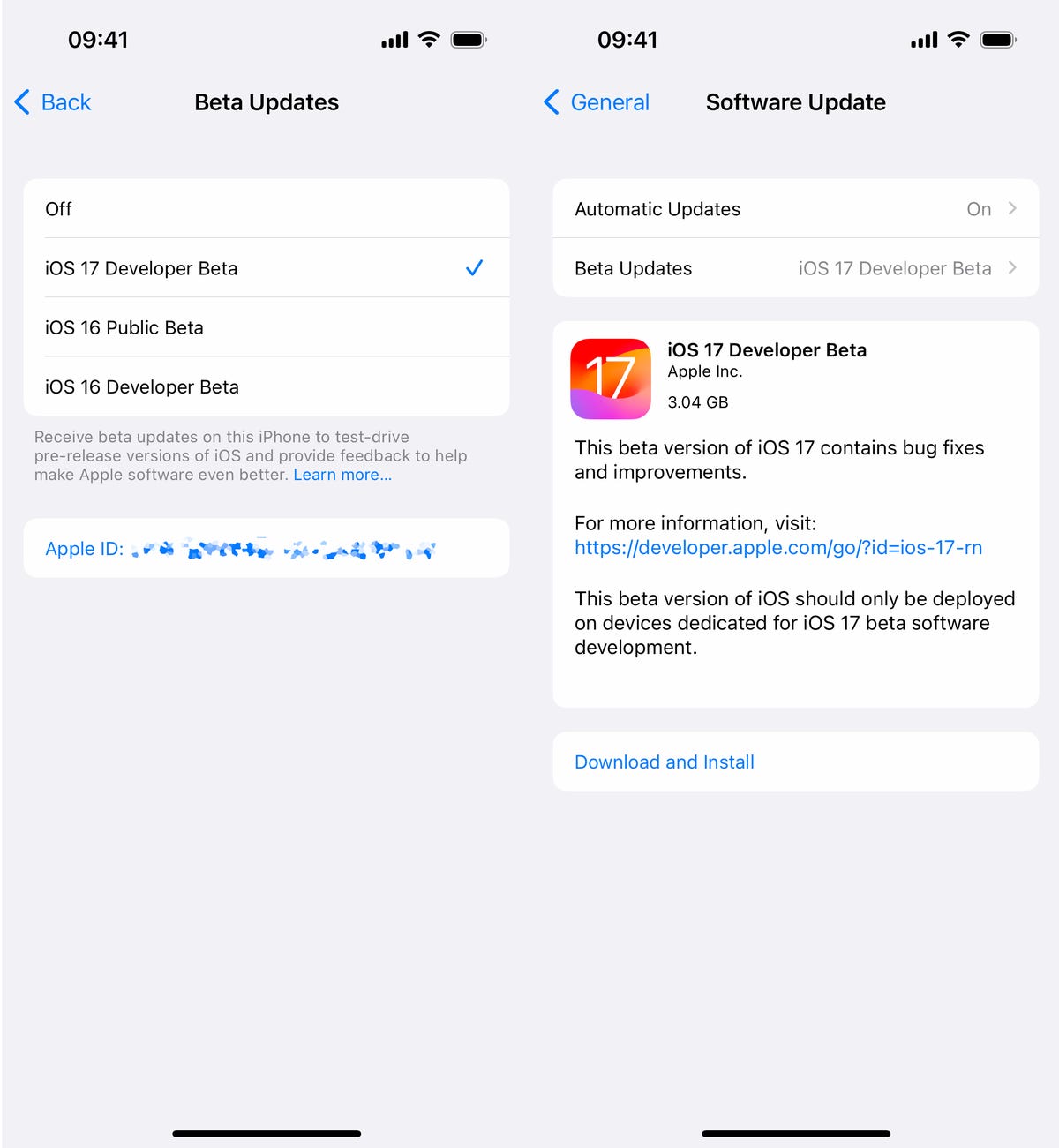
Or download the iOS 17 developer beta using your Mac
Over-the-air updates require a certain amount of storage, and if you don’t have that available, your computer is really the only way to update to iOS 17 beta without manually clearing out space.
1. On your Mac, go to the Apple Developer Program download page, find «iOS 17 beta,» click Download Restore Images and download the iOS beta software restore image for your specific device.
2. Connect your device to your computer and enter your device passcode or hit Trust This Computer if prompted.
3. Next, open Finder, click your device in the sidebar under Locations.
4. Hold down the Option key, click Check for Update and choose the iOS 17 beta software restore image you just downloaded from the Apple Developer page.
The iOS 17 beta software will install on your device. Wait for a few minutes and when your phone reboots, you should have access.
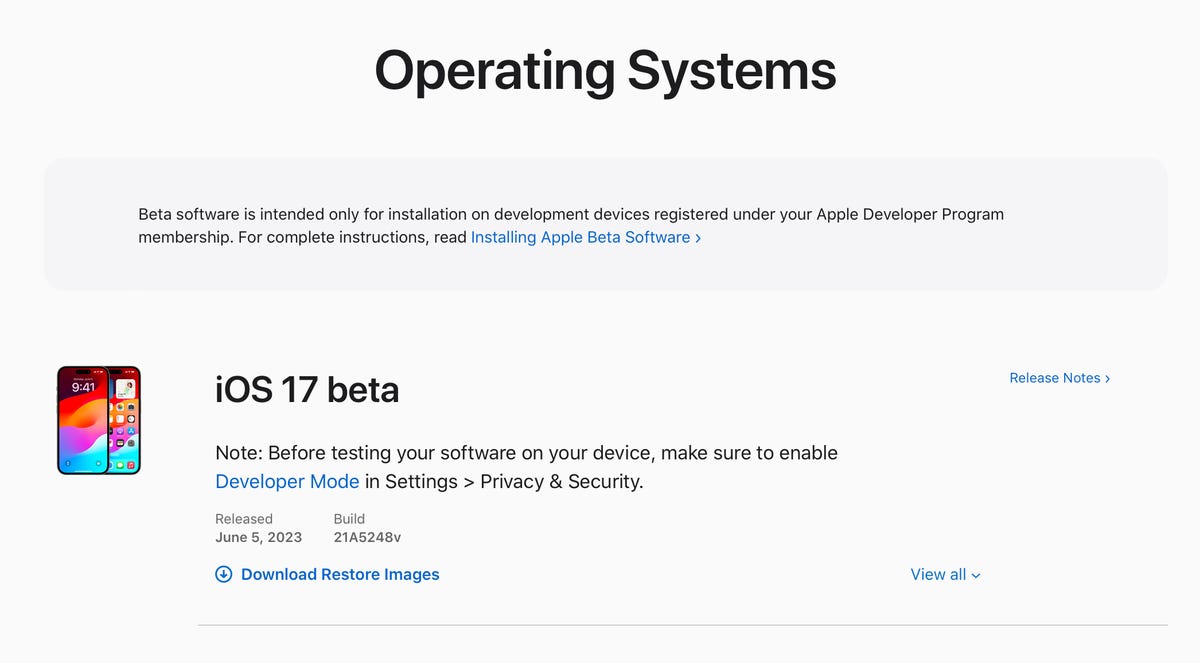
While you’re here, check out the best iPhone model you can get in 2023. And if you’re looking for a new computer, check out these laptops you might be interested in.
Technologies
Resident Evil Requiem: Release Date, Leon Kennedy’s Return Confirmed and More
The return to Raccoon City is going to be just as scary as you could have imagined.

The Game Awards on Thursday revealed new games such as Star Wars: Fate of the Old Republic and Control Resonant, but one of the biggest games shown was already revealed earlier in the year. Resident Evil Requiem is the ninth entry in the main Resident Evil series and takes players back to where the games started while seeing the return of a fan-favorite character.
A new trailer for Resident Evil Requiem finally reveals the antagonist of the game and confirms that Leon Kennedy is back, though it’s unclear what he’s been doing since Resident Evil 6. Also shown in the footage was Victor Gideon, a former doctor who looks like he’s been experimenting on people — and himself — as he intimidates the other main character players will control, Grace Ashcroft.
Don’t miss any of our unbiased tech content and lab-based reviews. Add CNET as a preferred Google source.
Resident Evil Requiem made its debut during the Summer Games Fest in June, and developer Capcom slowly released details about the upcoming horror game. What’s clear from the previously released footage and impressions is that Capcom really wants to terrify players — and it’ll go so far as to put players in Grace’s shoes without weapons.
When does Resident Evil Requiem come out?
Resident Evil Requiem will be released on Feb. 27, 2026, for PC, PS5 and Xbox Series consoles.
When does Resident Evil Requiem take place?
Resident Evil Requiem takes place 30 years after the events of Resident Evil 3: Nemesis, which was when Raccoon City was destroyed.
How will Resident Evil Requiem play?
After the trailer was shown, Game Awards host Geoff Keighley said Leon would bring «action-heavy gameplay» and that the game would offer two different experiences. This could mean that a good chunk of the game will be played as Grace, who will provide more of a survival-horror experience with fewer weapons and tools, while a portion of the game will be focused on Leon and his more chainsaw-wielding, kicking-in-the-face style of gameplay.
Read more: I Played Resident Evil 9 Requiem at Summer Game Fest, and It’s Extremely Messed Up
Who is Grace Ashcroft?
Grace Ashcroft is an FBI analyst who has a connection with Raccoon City. Her mother, Alyssa, was a survivor of the destruction of Raccoon City and was a playable character in the online game Resident Evil Outbreak, released on the PS2 in 2003. The elder Ashcroft was a reporter who told the story of what happened to the zombie-infested city, but was killed by a masked assailant in 2018.
Her murder spurred Grace to join the FBI. In Requiem, a mysterious infection is spreading, and deaths are mounting. Grace is assigned to investigate the Wrenwood Hotel, the place where the latest fatality has occurred, and which was the site of her mother’s murder. It’s from here that she’ll make her way to Raccoon City.
Where has Leon Kennedy been?
Leon was last seen in the series with Resident Evil 6, but he’s been active in the Resident Evil animated movies and series, including Resident Evil: Degeneration, Resident Evil: Damnation, Resident Evil: Vendetta, Resident Evil: Infinite Darkness and Resident Evil: Death Island. Leon is currently an agent for the Division of Security Operations and is deployed worldwide to investigate instances of bioweapons causing havoc, which often leads to reunions with other Resident Evil survivors, such as Jill Valentine, Chris Redfield and Rebecca Chambers.
Are there any other characters set to be revealed?
A GameStop listing for Resident Evil Requiem listed the Expansion Pass for the game and the additional scenarios, according to a report from Videogame Chronicles on Tuesday. One scenario referred to a Shadow Walker Costume Pack, which includes outfits for Rosemary Winters, the daughter of Resident Evil 7 and Resident Evil Village hero Ethan Winters. Rosemary was the main character of Shadows of Rose, a postrelease content scenario for Resident Evil Village.
There could be additional characters revealed in the coming days as Resident Evil Requiem’s release date nears.
Technologies
Today’s NYT Connections: Sports Edition Hints and Answers for Dec. 13, #446
Here are hints and the answers for the NYT Connections: Sports Edition puzzle for Dec. 13, No. 446.
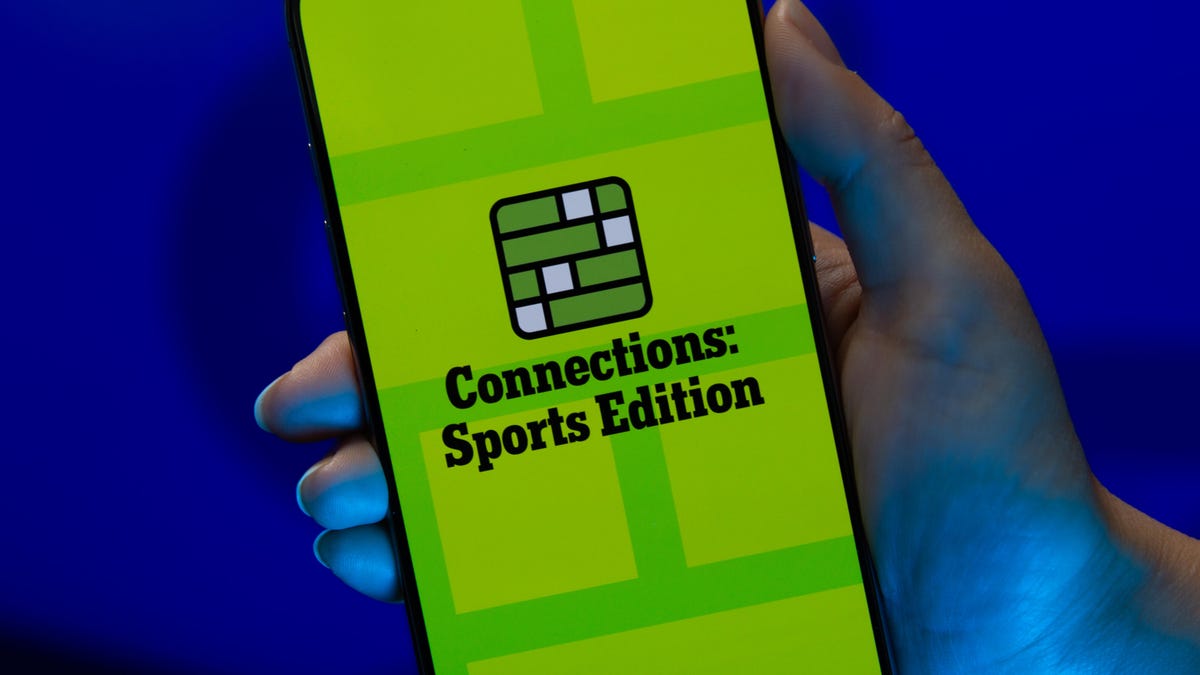
Looking for the most recent regular Connections answers? Click here for today’s Connections hints, as well as our daily answers and hints for The New York Times Mini Crossword, Wordle and Strands puzzles.
Today’s Connections: Sports Edition is a tough one. The purple category wants you to look inside of different words and see if you recognize other related words. If you’re struggling with today’s puzzle but still want to solve it, read on for hints and the answers.
Connections: Sports Edition is published by The Athletic, the subscription-based sports journalism site owned by The Times. It doesn’t appear in the NYT Games app, but it does in The Athletic’s own app. Or you can play it for free online.
Read more: NYT Connections: Sports Edition Puzzle Comes Out of Beta
Hints for today’s Connections: Sports Edition groups
Here are four hints for the groupings in today’s Connections: Sports Edition puzzle, ranked from the easiest yellow group to the tough (and sometimes bizarre) purple group.
Yellow group hint: Get your racket.
Green group hint: Football, February to September.
Blue group hint: College gridiron stars.
Purple group hint: Look for hidden teams.
Answers for today’s Connections: Sports Edition groups
Yellow group: Scoring in tennis.
Green group: NFL offseason events.
Blue group: Heisman Trophy finalists.
Purple group: Starts with an NFL team in singular form.
Read more: Wordle Cheat Sheet: Here Are the Most Popular Letters Used in English Words
What are today’s Connections: Sports Edition answers?
The yellow words in today’s Connections
The theme is scoring in tennis. The four answers are 15, 30, 40 and deuce.
The green words in today’s Connections
The theme is NFL offseason events. The four answers are combine, draft, OTAs and training camp.
The blue words in today’s Connections
The theme is Heisman Trophy finalists. The four answers are Love, Mendoza, Pavia and Sayin.
The purple words in today’s Connections
The theme is starts with an NFL team in singular form. The four answers are beard, billboard, brownie and jettison.
Don’t miss any of our unbiased tech content and lab-based reviews. Add CNET as a preferred Google source.
Technologies
Google Turns Ordinary Headphones Into Instant Language Interpreters
Google is rolling out a beta version of the Translate app with support for more than 70 languages.

Google is taking on Apple’s Live Translation feature with its own live speech-to-speech translations, and Google’s version doesn’t require a specific set of headphones.
The new Translate app, currently rolling out in beta, provides you with real-time translation in your preferred language when you tap «Live Translate.» The function, now usable on any headset, was only previously available on Pixel Buds.
Don’t miss any of our unbiased tech content and lab-based reviews. Add CNET as a preferred Google source.
The Translate Android app update is rolling out in the US, Mexico and India, and it supports more than 70 languages. The company says it will bring the feature to iOS, and more countries, in 2026.
In addition, the company announced it was improving translation quality using Gemini, Google’s AI model, and said that idioms, in particular, were no longer literal translations, but more contextual. Google said that it was also expanding the language learning tools with more feedback and daily challenges.
Meanwhile, as part of iOS 26, Apple recently introduced Live Translation, but the live audio version is currently limited to use with the AirPods Pro or AirPods 4.
-

 Technologies3 года ago
Technologies3 года agoTech Companies Need to Be Held Accountable for Security, Experts Say
-

 Technologies3 года ago
Technologies3 года agoBest Handheld Game Console in 2023
-

 Technologies3 года ago
Technologies3 года agoTighten Up Your VR Game With the Best Head Straps for Quest 2
-

 Technologies4 года ago
Technologies4 года agoBlack Friday 2021: The best deals on TVs, headphones, kitchenware, and more
-

 Technologies4 года ago
Technologies4 года agoVerum, Wickr and Threema: next generation secured messengers
-

 Technologies4 года ago
Technologies4 года agoGoogle to require vaccinations as Silicon Valley rethinks return-to-office policies
-

 Technologies4 года ago
Technologies4 года agoOlivia Harlan Dekker for Verum Messenger
-

 Technologies4 года ago
Technologies4 года agoiPhone 13 event: How to watch Apple’s big announcement tomorrow
